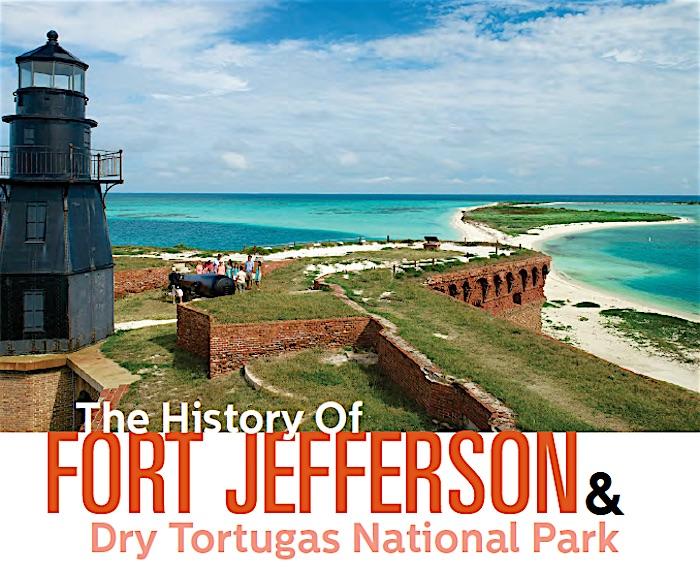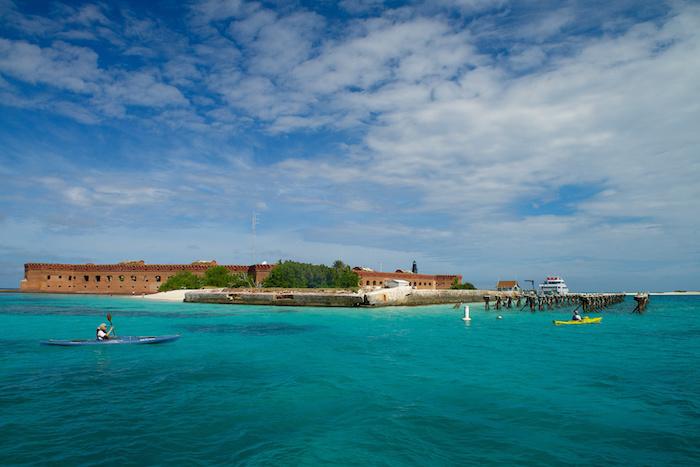
Editor's note: The following is an advertiser-supported article from Traveler's Essential Park Guide, Spring 2018.
What do you think about when you hear the words “national park”? For most, it’s likely visions of park rangers sporting knee-length khaki shorts and wide-brimmed Smokey Bear style hats. Or maybe it’s the verdant, rugged majesty of Yellowstone National Park with its geothermal wonders and grizzly bears.
One thing is for certain: the remote island chain that makes up the Dry Tortugas would never enter your mind, and that is a shame. Because as beautifully strange as the stalactites of Carlsbad Caverns are, and as awesome as the volcanic wonders found in Hawai’i Volcanoes National Park certainly are, Dry Tortugas National Park should definitely be in the conversation as one of the more unique places in the entire National Park System.
If you’re ready to take the plunge and see this natural wonder with your own eyes, your first step is getting to Key West. Once there, hop aboard the Yankee Freedom III, a high-performance, luxury catamaran that ferries visitors to and from the Dry Tortugas year-round. Two hours and 70 miles later, you will make landfall on the most isolated national park in the Continental United States.
Spanish explorer Ponce de Leon in 1513 discovered this blue, virtually deserted oasis. He dubbed the cluster of seven contiguous islands, ‘Las Tortugas,’ which translates to ‘The Turtles,’ so named for the abundance of sea turtles that had migrated there. The addition of the word ‘Dry’ was intended as a warning to future seafaring expeditions that the island was deprived of fresh water.

Fort Jefferson presented a mighty fortress protecting the Florida Straits and the U.S. interests in keeping those straits open / Yankee Freedom
The Dry Tortugas also makes what sailors call a perfect recipe for a shipwreck: Low land, a large fringe reef, tides that vary with the seasons, and a strong current. Toss in a hurricane and you’ve got the makings for a high-speed collision. It was also the perfect spot for the U.S. government to build a stronghold; in this case, a naval fort that would secure shipping lanes for the unfettered importing and exporting of goods between the nation’s southern coast and the Mississippi River and to serve as a deterrent to piracy. Construction began in 1846, and continued for nearly 30 years, until 1875 when Fort Jefferson was deemed finished.
This massive, enclosed hexagonal structure built from 16 million bricks became one of the most geographically desirable military structures in America’s arsenal, along with becoming the largest structure built from brick in the Western Hemisphere. In order to ensure the safe passage of friendly vessels, a lighthouse was constructed on Garden Key to illuminate the treacherous reefs and shoals responsible for sinking hundreds of ships since the fort’s inception.
Named after the third president of the United States, Thomas Jefferson, the fort had as many as 2,000 military personnel and civilians who called it home. With blacksmiths, cooks, a doctor, and others with specialized skills, the fort functioned almost like a miniature city. There were, however, certain aspects of the fort that lacked what one might call hospitable environs, as there was a prison on the premises that incarcerated mainly deserters from the Union Army during the Civil War.
The prison’s most famous inmate was Dr. Samuel Mudd, convicted for his role as co-conspirator in the assassination of President Abraham Lincoln. Though he was sentenced to life in prison, he was pardoned by President Andrew Johnson four years into his sentence because of his invaluable assistance in stemming a serious outbreak of yellow fever that would have otherwise ravaged the fort’s population.
When it came to sheer, brute firepower, Fort Jefferson had no equal. The design of the fort called for a three-tiered, six-sided, 420 heavy-gun fort, with two sides measuring 325 feet, and four sides measuring 477 feet. The walls meet at corner bastions, which are large projections designed to allow defensive fire along the faces of the walls they joined. The heavy guns were mounted inside the walls in a string of open casemates, or gunrooms, facing outward toward the sea through large openings called embrasures.

Whether you swim, snorkel, or kayak at Dry Tortugas National Park, Fort Jefferson is always within sight / Yankee Freedom
Fort Jefferson was designed to be a massive gun platform, impervious to assault, and able to destroy any enemy ships foolhardy enough to come within range of its powerful guns. The intimidation factor of the fort was such that while it was still on active duty prior to its decommissioning, it was never fired upon by hostile forces.
Near the close of the 19th century, the fort became obsolete and fell out of favor with top military brass. Not only had the conditions of the modern world outgrown the fort’s usefulness, but also its location, exposed to the elements smack dab in the middle of the Florida Straits, caused it to slowly fall into disrepair. Corrosive salt air and violent hurricanes that would wreak havoc in the area proved too costly, and the fort was eventually shuttered. Much later, President Franklin Delano Roosevelt designated it as a national monument in 1935, and in 1992 it was redesignated as a national park.
What’s lost in all this history, captivating as it is, is the fact that Fort Jefferson comprises exactly 1 percent of the area protected by the National Park Service. The other 99 percent lies beneath the crystal blue waters that surround it. The reefs here are vibrant and teeming with marine life. Because the reefs are so shallow, the sun can nurture the sea life below with unobstructed light.
The many shipwrecks in the area help fortify and sustain the ecosystem by serving a second life as an artificial reef. Hundreds of species of marine animals can be encountered here, with opportunities to view sharks, various species of coral, lobsters, squid, octopus, tropical reef fish, goliath groupers, and of course, sea turtles.
However, not all the wildlife here spends its life submerged under water. The Dry Tortugas is also a world-class bird-watching destination with more than 300 species of birds passing through and nesting on the islands.
As far as national parks go, Dry Tortugas remains an enigma, giving the island a certain mystique. Because of the remote location and limited means to get there, it restricts visitation to lower levels than you would find in most other parks.
However, those who have been fortunate enough to set foot there will tell you the trip was definitely worth it. You can hear it in the impassioned oohs and ahhs that weave through stories that tell of the spell they fell under while gazing at the endless turquoise ocean that stretches as far and deep as your imagination.



Comments
My wife and I spent most of a day at the DTNP. The snorkeling was good. Take a picnic lunch, water, and sunscreen. We flew in on a pontoon aircraft - fast and fun.
We took the seaplane there. Loved touring the fort and the natural beauty was fantastic. Well off the beaten path but worth it. In key West we toured Truman's white house, highly recommend that too.